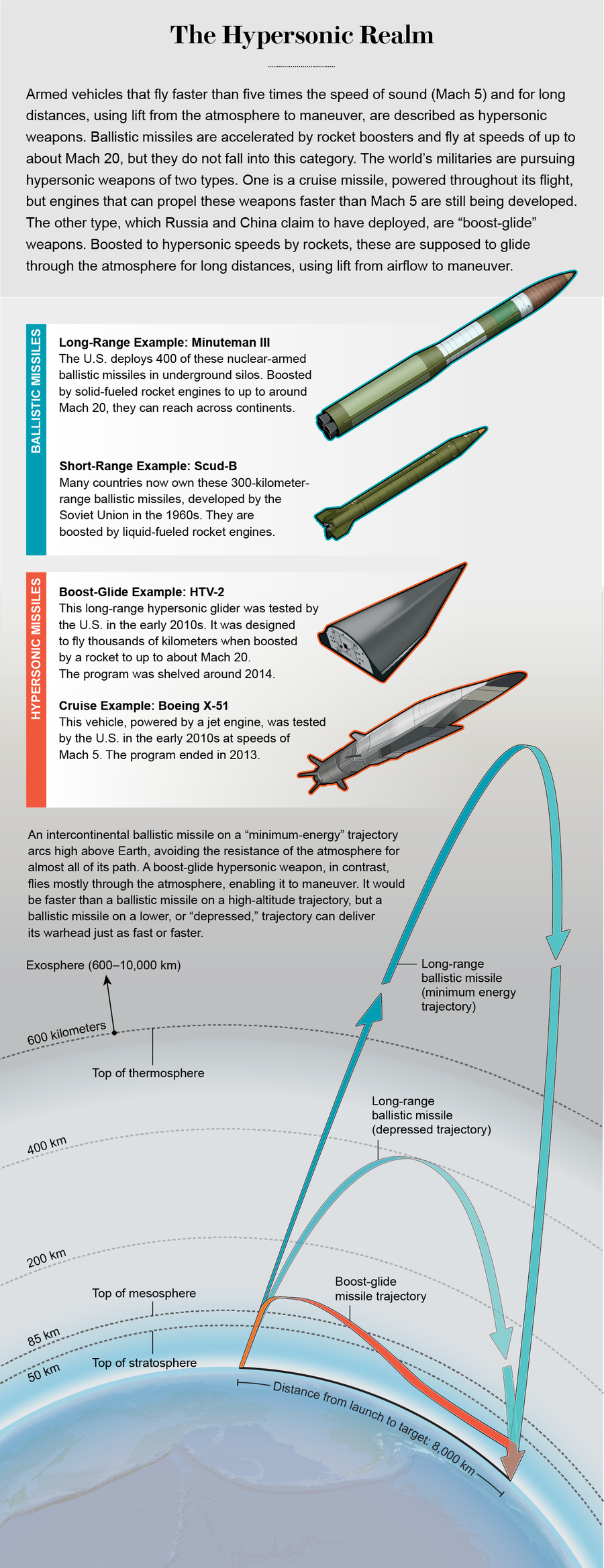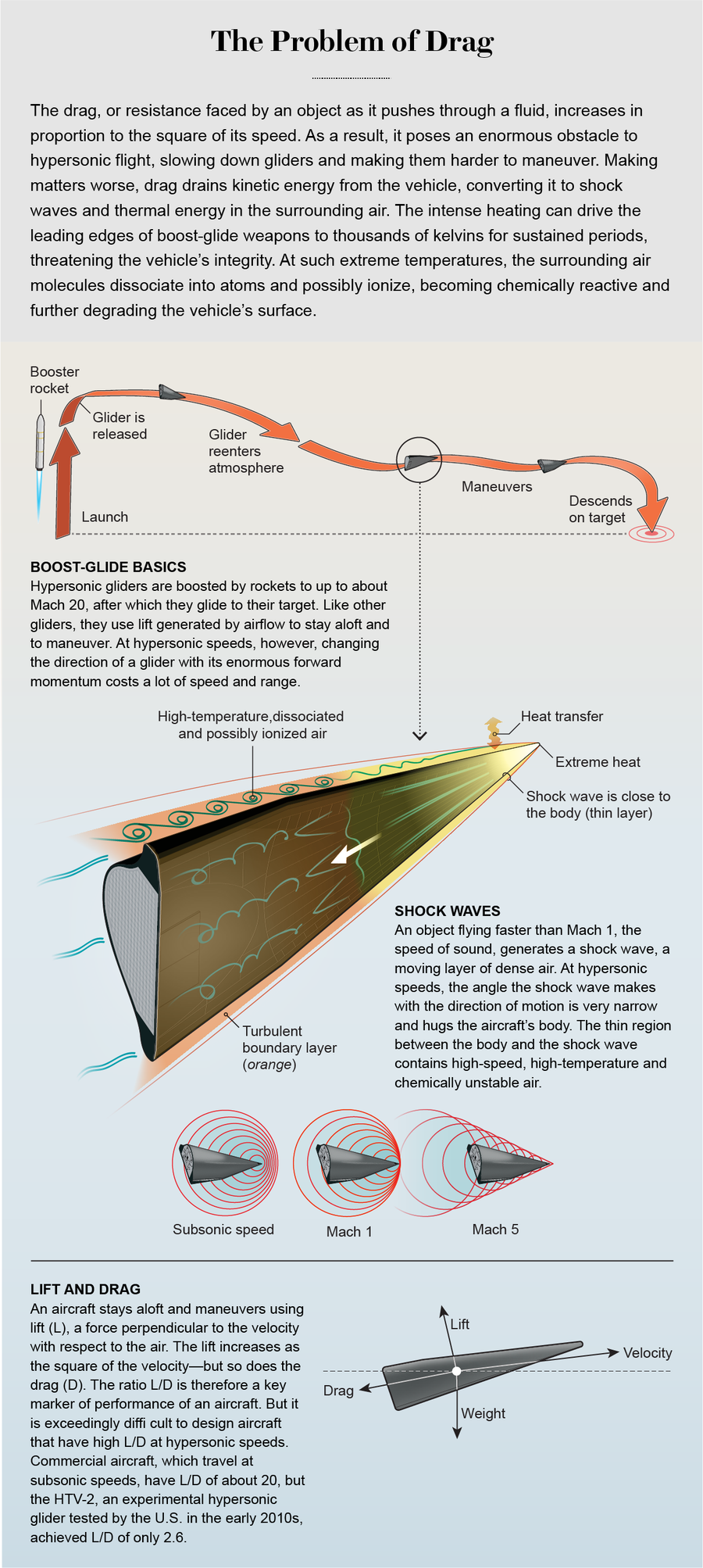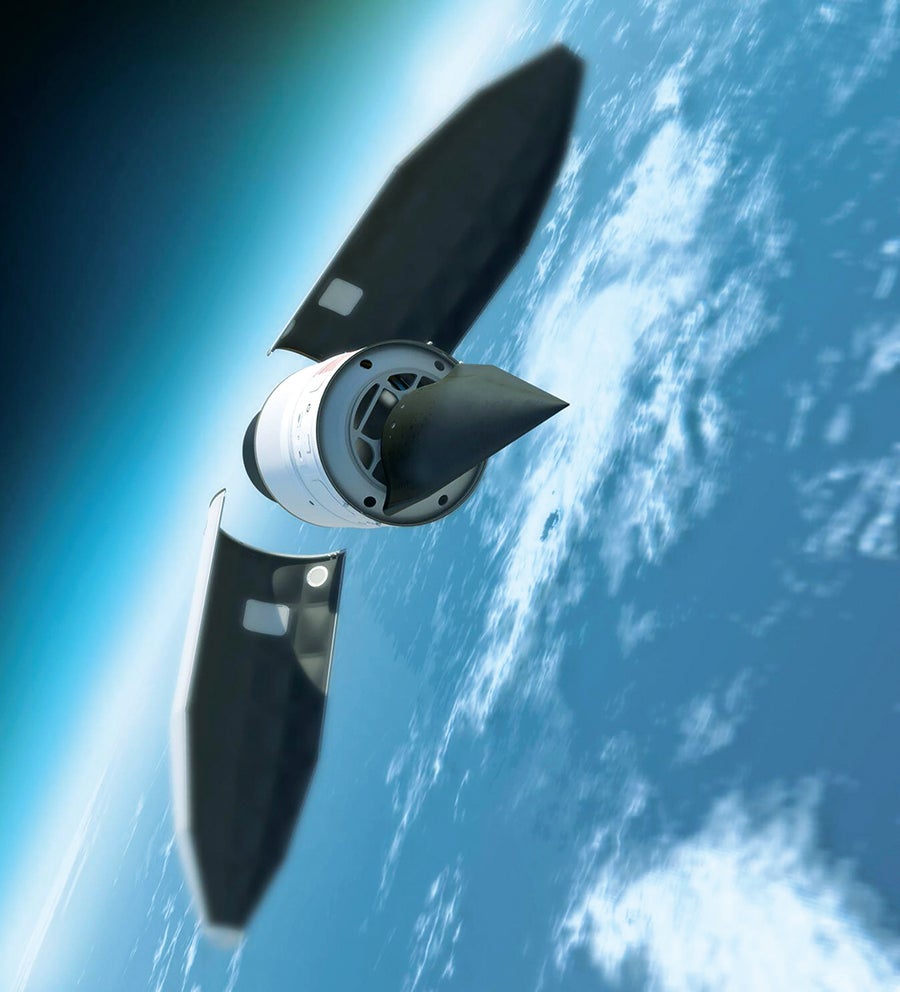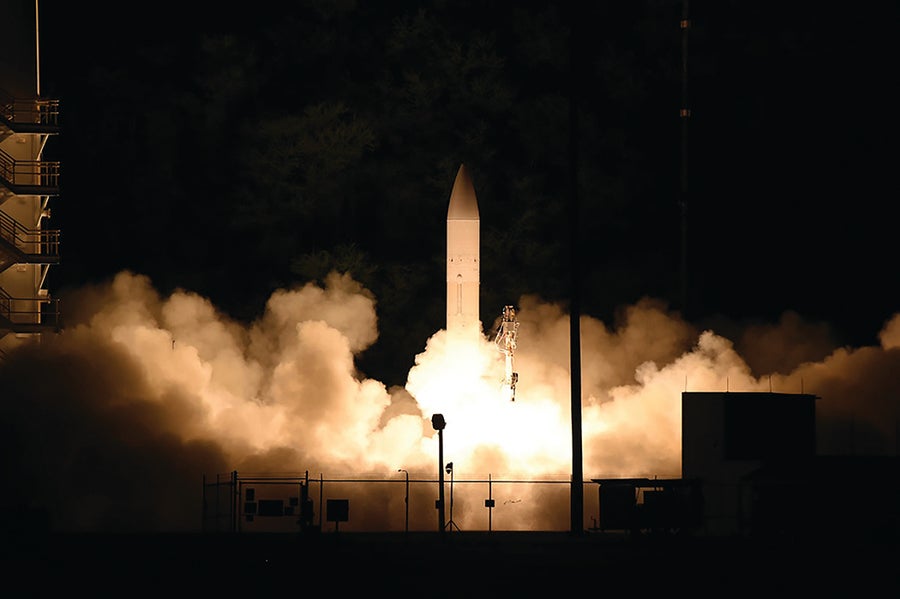In a televised address to Russia’s Federal Assembly in 2018, President Vladimir Putin announced an escalation of the ongoing arms race with the U.S., which had withdrawn from the Anti-Ballistic Missile (ABM) Treaty in 2002. Having rejected the decades-long arms-control agreement, the U.S. had developed and begun building a network of defenses to intercept long-range ballistic missiles, threatening Russia’s ability to deter attacks on its homeland. He had warned Americans that Russia would be forced to respond to these deployments, Putin told his audience, but they had refused to listen. “So listen now!”
Among other systems, Russia was developing new hypersonic weapons, Putin declared: missiles that fly long distances through the atmosphere at more than five times the speed of sound, or faster than Mach 5. (Mach 1 is the local speed of sound. Speeds between Mach 1 and Mach 5 are supersonic, whereas those exceeding Mach 5 are hypersonic.) According to him, one of these, called Avangard, was a highly maneuverable missile that could glide thousands of kilometers with an initial speed greater than Mach 20, making it “absolutely invulnerable to any air or missile defense system.”
Putin’s announcement, accompanied by intimidating simulations of the new weapons snaking across the globe at unbelievable speeds, added fuel to a dangerous new arms race. The weapons involved in this competition are touted not only for their speed but also for their stealth and maneuverability. Intercontinental ballistic missiles, which follow an elliptical path into space before plunging down toward their target, reach speeds above Mach 20, but they have predictable trajectories for most of their flight and typically can maneuver only briefly, after they reenter the atmosphere. In contrast, hypersonic weapons would fly deep within the atmosphere most of the time, using lift generated by airflow to weave around and try to evade interceptors. Approaching at such low altitudes, these weapons would avoid detection by ground-based radar systems until close to their target, making them more difficult to stop.
On supporting science journalism
If you're enjoying this article, consider supporting our award-winning journalism by subscribing. By purchasing a subscription you are helping to ensure the future of impactful stories about the discoveries and ideas shaping our world today.
In an assessment after Putin’s speech, U.S. military officials stated that hypersonic weapons, which China was also developing, would “revolutionize warfare.” The Pentagon, which had been working on similar systems for a decade and a half, ramped up its own efforts; last year Congress dedicated $3.2 billion to the research and development of hypersonic weapons and defenses. Russia and China now claim to each have deployed at least one such system. The U.S. has six known hypersonic programs, divided among the air force, army and navy. Proponents say that these weapons are incredibly fast and agile and virtually invisible.
We disagree. We belong to a small but vibrant community of physicists and engineers scattered around the globe who study new weapons systems to understand their potential impacts on global security. This tradition is deep, going back to participants in the Manhattan Project and Russian scientists such as Andrei Sakharov, who sought to mitigate the danger to the world from the nuclear weapons they had helped create. As investigative physicists, we glean what information we can about new and usually secretive technologies, analyze it and share our evaluations with the public.
Our studies indicate that hypersonic weapons may have advantages in certain scenarios, but by no means do they constitute a revolution. Many of the claims about them are exaggerated or simply false. And yet the widespread perception that hypersonic weapons are a game-changer has increased tensions among the U.S., Russia and China, driving a new arms race and escalating the chances of conflict.
Fits and Starts
Militaries have pursued hypersonic aircraft for almost a century, though with limited success. In the late 1930s Austrian engineer Eugen Sänger and German physicist Irene Bredt designed the first hypersonic aircraft, a glider called the Silbervogel. It was to be launched from a rocket, fly primarily within the atmosphere and, like any other glider, stay aloft using aerodynamic lift, but Nazi planners decided it would be too difficult and expensive to build.
During World War II, German engineers developed rocket engines, which burn propellant, a mixture of fuel and chemical oxidizer, to release an intense burst of energy. In subsequent decades, experimental rocket-powered aircraft broke speed record after speed record. In October 1947 the rocket-propelled X-1 became the first piloted aircraft to officially break the sound barrier—crossing Mach 1—and in the 1960s the X-15 reached Mach 6.7 during tests. The strong g-forces produced by rocket engines placed extreme demands on human physiology, so piloted rocket-propelled aircraft never became more than experiments. But rocket technology enabled the U.S. and the Soviet Union to build arsenals of nuclear-armed ballistic missiles that are boosted to more than Mach 20 to reach across continents.

Credit: Ben Gilliland

Credit: Ben Gilliland; Source: “Supersonic Combustion in Air-Breathing Propulsion Systems for Hypersonic Flight,” by Javier Urzay, in Annual Review of Fluid Mechanics, Vol. 50; January 2018 (boost-glide weapon flow physics reference)
Another technology developed in this era, the jet engine, became the workhorse of military and commercial travel, however. Drawing in atmospheric oxygen to continuously burn fuel, a jet engine does not carry the extra weight of an oxidizer. It enables long-distance transport and maneuverability without the extreme acceleration of rocket engines. Today the fastest official speed for a piloted jet aircraft stands at approximately Mach 3, which the Lockheed SR-71 Blackbird reached in July 1976. Jet engines also power cruise missiles—maneuverable and pilotless aircraft, the fastest of which can achieve supersonic speeds.
Meanwhile hypersonic gliders continued to soar—and drop. In 1963, after spending over $5 billion (in current dollars) developing the X-20 Dyna-Soar hypersonic glider, the U.S. abandoned the design. But after the Al Qaeda attacks on September 11, 2001, President George W. Bush directed the development of hypersonic missiles that could quickly and accurately disrupt terrorist activities on different continents with nonnuclear warheads. (Ballistic missiles could do the job, but the launch of such a weapon could be mistaken for a nuclear attack, provoking a nuclear war.)
Bush also withdrew from the Anti-Ballistic Missile treaty, which the U.S. and the Soviet Union had signed in 1972. The treaty had stopped the adversaries from constructing defensive shields against each other’s ballistic missiles—and thereby halted a race for technologies to build shields and break through those of the other side. Instead the Bush administration proceeded to develop and deploy interceptors to protect against long-range ballistic missiles. Fearing that their ability to deter a U.S. nuclear attack would be compromised, Russia and, more recently, China, began to pursue diverse stratagems for surmounting the U.S. shield. The most recent of these devices are hypersonic missiles, which fly too low to be blocked by current U.S. interceptors of long-range ballistic missiles. In sum, the 9/11 attacks provoked a series of hasty decisions that have brought the three superpowers to the present situation, in which they are all racing to develop hypersonic weapons based on various technologies and designed for various purposes.
Drag and Lift
Hypersonic systems deployed in the near term will be “boost-glide” weapons, which would be launched by a rocket booster and then glide long distances without propulsion. (The U.S. and other countries are also working to build hypersonic cruise missiles, but their engines are still under development.) Yet our studies indicate that hypersonic gliders encounter severe challenges. Physics gets in the way.
Designers of hypersonic vehicles face a daunting adversary: drag, the resistance a fluid offers to anything moving through it. The drag on a flying object increases in proportion to the square of its velocity, making it particularly debilitating at hypersonic speeds. A glider at Mach 5 is subjected to 25 times the drag force than when it flies at Mach 1, for example, and one at Mach 20 faces 400 times the drag of when it is at Mach 1.
Even more severe is the energy drain from an aircraft as it pushes the molecules of air forward and aside: it increases as the cube of the velocity. So a glider flying at Mach 5 will lose energy 125 times faster than at Mach 1; one flying at Mach 20 will lose energy 8,000 times faster. Just as problematic, the kinetic energy flowing from the glider to the surrounding air transforms to thermal energy and shock waves. Some of that energy transfers back to the vehicle as heat: leading edges of boost-glide weapons flying at Mach 10 or above can reach temperatures above 2,000 kelvins for sustained periods. Protecting a vehicle from this intense heat is one of the biggest problems facing engineers.
At the same time, like any other glider, a hypersonic one must generate lift—a force perpendicular to its direction of motion—to stay aloft and to turn. (A glider turns by banking or otherwise inducing a horizontal component of the lift force.) As it happens, lift is also proportional to the square of the velocity. Moreover, the aerodynamic processes that produce lift also unavoidably generate drag. The ratio of the lift force, L, to the drag force, D, is called the lift-to-drag ratio, L/D, a key marker of a glider’s performance.
Achievable values of L/D for hypersonic vehicles are much lower than for conventional aircraft. For subsonic aircraft, the ratio can be 15 or larger. Yet after decades of research and development, U.S. hypersonic weapons tested in the past decade appear to have L/D values less than three. Such low L/D ratios mean low lift and high drag—which limits the speed and range of a hypersonic glider, reduces its maneuverability and increases surface heating.
As if that were not enough, the physics and chemistry of air flowing past an object become radically different at hypersonic speeds. Heated to thousands of degrees, the surrounding air dissociates, converting molecular oxygen into free atoms that can ionize and scour away the surface of the vehicle. Even if the missile survives the roasting, the heating produces a bright infrared signal that satellites can see.
No Silver Bullet
In the early 2010s the U.S. flight-tested a long-range glider, the Hypersonic Technology Vehicle 2 (HTV-2). It was designed to glide up to 7,600 kilometers after being boosted to an initial speed of Mach 20 by a rocket. We combined data from these tests with other information about the vehicle to construct detailed computer simulations of hypersonic flight. We also compared the performance of boost-glide weapons with long-established technologies, such as ballistic or cruise missiles, on the three abilities in which hypersonic weapons are said to be exceptional—delivery time, maneuverability and stealth.
Hypersonic weapons are often said to reduce the time needed to deliver a warhead, but this claim is largely based on a misleading comparison with subsonic cruise missiles or with ballistic missiles on longer trajectories. The most energy-efficient path for a ballistic missile, called a minimum-energy trajectory, sends a warhead arcing high above Earth before it falls to its target. The warhead avoids atmospheric drag over most of its flight but follows a much longer path than a hypersonic glider would, so it can take somewhat longer to reach the same target.
Yet a ballistic missile can instead fly at lower altitude, called a depressed trajectory—long seen as a way of delivering quicker nuclear attacks from submarines. Such a path would be much shorter than a minimum-energy one, and a warhead following it would also avoid drag over most of its trajectory. In contrast, a hypersonic glider spends significantly more time within the atmosphere, where drag reduces its speed. Our calculations show that a ballistic missile on a depressed trajectory can deliver a warhead with an equal or shorter flight time than a hypersonic weapon over the same range.
Maneuvering is another advertised advantage of hypersonic weapons. Again, the reality is more complicated. The U.S. has developed and tested maneuvering reentry vehicles (MaRVs)—warheads that use aerodynamic forces to change direction as they near the target, helping to increase accuracy and evade missile defenses—for ballistic missiles for decades: maneuverability is not unique to hypersonic weapons. To be sure, MaRVs typically twist and turn only late in flight. They cannot snake around during their entire course as hypersonic gliders are supposed to do. But the maneuverability of hypersonic gliders is constrained by the great forces needed to turn a vehicle flying at such tremendous speeds.


HTV-2 GLIDER (top), shaped like an arrowhead and shown prior to its launch from a rocket, was tested by the U.S. military in the early 2010s but failed to perform as advertised. A rocket booster (bottom) launches a different hypersonic glider the Pentagon is developing, based on a 1970s conical design. Credit: Volgi Archive and Alamy Stock (top); Oscar Sosa and U.S. Navy (bottom)
To change direction, a hypersonic glider must use lift forces to impart a horizontal velocity—which might itself have to be hypersonic. For example, to turn by 30 degrees, a glider flying at Mach 15, or 4.5 kilometers per second, must generate a horizontal velocity of Mach 7.5, or 2.3 kilometers per second. (Because the speed of sound changes with density and altitude, flight engineers often take Mach 1 to be about 300 meters per second, and so do we.) At the same time, the glider must retain enough vertical lift to stay aloft. Such maneuvers can cost significant speed and range.
To generate the extra lift needed to change direction, the vehicle could dive to a lower altitude to use the greater push from denser air. It would make its turn before returning to a higher altitude, with less drag, to resume its flight. Going to lower altitudes would reduce the time needed to turn but also increase the drag that the vehicle experiences. For example, at Mach 15 a glider such as the HTV-2 would fly at an altitude of about 40 kilometers. If it drops by about 2.5 kilometers, then turning by 30 degrees would take about seven minutes, during which it would travel along a vast arc, with a radius of some 4,000 kilometers. The extra drag that comes from traveling in denser air, even for such a short time, would reduce the glider’s speed by about Mach 1.3, causing it to lose about 450 kilometers of range out of the 3,000 kilometers it might otherwise have traveled.
Some amount of midcourse maneuvering, such as for selecting a new target, can be useful, and gliders could likely make larger maneuvers than ballistic missile warheads can. Still, MaRVs can already maneuver by hundreds of kilometers during reentry, so it is hard to see how this ability is revolutionary.
Another common claim is that because gliders travel at lower altitudes than a ballistic warhead, they would be “nearly invisible” to early-warning systems. A ground-based radar system can spot a warhead at an altitude of 1,000 kilometers from about 3,500 kilometers away, but because of the earth’s curvature it would not see a glider approaching at a height of 40 kilometers until it was only about 500 kilometers away. But both the U.S. and Russia have early-warning satellites with sensitive infrared sensors that could spot the intense light that gliders emit because of their extreme temperatures. Our analysis indicates that currently deployed U.S. satellites would be capable of detecting and tracking gliders traveling through the atmosphere at speeds covering most of the hypersonic regime.
Gliders deployable in the foreseeable future might avoid being seen by U.S. satellites if they fly at the low end of the hypersonic range— below about Mach 6. This concern appears to be motivating U.S. research into new constellations of satellite sensors. But a boost-glide vehicle similar to the HTV-2 with an initial speed of Mach 5.5 would travel less than 500 kilometers, so flying at these speeds would significantly limit its range. Hypersonic cruise missiles could conceivably maintain these low speeds over longer distances. Such slow speeds may, however, negate another key argument for hypersonic weapons—their ability to avoid terminal missile defenses.
Russia and China seem to be developing hypersonic weapons largely because of their ability to evade U.S. missile defense systems. The U.S. Ground-based Midcourse Defense and ship-based Aegis SM-3 systems, which are intended to defend the U.S., Japan, and other countries, intercept above the atmosphere and are unable to engage hypersonic weapons flying in at lower altitudes. Hypersonic gliders with sufficient speed and maneuverability could also evade defenses of shorter range that work within the atmosphere, such as the U.S. Patriot, SM-2 and THAAD systems. These interceptors protect small regions, tens of kilometers across, around military sites and ships, using lift forces for turning to intercept incoming weapons. Their efficacy depends on their being more maneuverable than the missile they are trying to hit, which in turn depends strongly on flight speed. Patriot interceptors, for example, use rocket boosters to reach speeds of up to Mach 6. A hypersonic weapon could likely outmaneuver these interceptors if it maintained high speeds—but could become vulnerable to them when flying below about Mach 6. Thus, almost as soon as a hypersonic glider becomes invisible to satellites (but possibly visible to ground radar), it can become susceptible to interception.
Moreover, the ability to penetrate defensive shields is not unique to hypersonic gliders. Interceptors that operate outside the atmosphere are particularly vulnerable to being fooled by decoys and other countermeasures, which Russia and China have developed and likely deployed. Ballistic missiles of short and medium range, launched from an aircraft, could fly at altitudes low enough to avoid such “exo-atmospheric” defenses. Similarly, equipping ballistic missiles, including missiles of short and medium range, with MaRVs could allow them to outmaneuver and penetrate defenses that operate within the atmosphere.
Today the U.S. has shifted its focus from developing long-range gliders such as the HTV-2 toward hypersonic systems of shorter range, of up to a few thousand kilometers. This change is motivated not only by the shortcomings of the prototype HTV-2 glider, which the tests had revealed, but also by a new mission: to use weapons in a local, or “theater,” conflict to penetrate and destroy defensive systems. In terms of capabilities, however, these shorter-range hypersonic gliders are virtually indistinguishable from MaRV-tipped ballistic missiles flying on depressed trajectories. The similarity became obvious in 2018, when the U.S. Department of Defense announced its choice of design for a hypersonic vehicle intended for joint use by the army, navy and air force. Rather than opting for a wedge shape like that of the HTV-2, which would increase the value of L/D, the Pentagon chose an older conical design based on an experimental MaRV originally developed in the 1970s. This weapon would have a lower range and less maneuverability, the Pentagon acknowledged, but the technology was less risky.
A design from the 1970s is hardly revolutionary. It looks to us like the Pentagon is using the hype about hypersonic weapons to secure funding from Congress while reverting to a technology developed half a century ago for its main system. While the Pentagon is putting some funds into other designs, its focus is not the revolutionary systems that were advertised.
Waverider
Significantly enhancing L/D, if possible, would reduce the technical barriers to long-range hypersonic flight. Theoretically, “waverider” designs can increase the L/D values of hypersonic vehicles to six or higher. These use a wedge shape that matches the shock-wave pattern of the airflow around the glider at a given speed and altitude, enclosing part of the shock wave under the vehicle to provide additional lift.
This concept dates from the late 1950s but has proved difficult to transform into working vehicles. The HTV-2 was in fact based on such a design—but achieved an L/D value of only 2.6. Even so, in 2020 the air force withdrew from the Pentagon’s joint hypersonic program and announced that it would pursue a wedge design like that of the HTV-2 for a short-range glider. Increasing L/D to four or six would help reduce heat loads and increase a glider’s range. But would such improvements open new possibilities for military uses?
We think not. Heating remains a major challenge because the surface temperature of a vehicle falls rather slowly with increases in L/D. Our calculations show, for example, that increasing L/D from 2.6, the value that the HTV-2 achieved, to 6 would reduce a glider’s surface temperature at a given speed by at most 15 percent. Preventing material damage during long-range flights would therefore still be difficult. Such an increase in L/D would also reduce the infrared signature of a missile and potentially increase the speed at which it could fly undetected (by current satellites) to up to Mach 7. Increasing L/D could in addition provide somewhat higher maneuverability—but that could be more easily boosted by relatively small increases in a glider’s initial speed. (Recall that maneuverability depends on lift, which increases as the square of the velocity.) For such reasons, it does not look like foreseeable advances in hypersonic gliders, such as increasing L/D, would give hypersonic weapons revolutionary capabilities.
Despite this reality, the hype around hypersonic weapons has driven big increases in spending on these systems and heightened fear, distrust and the risk of conflict among the U.S., Russia and China. The prospect of fast and potentially undetected attacks, even if exaggerated, could prompt these countries to react quickly and rashly to warnings, either real or mistaken, increasing the chances of blundering into conflict.
By providing technical analyses of new military systems, independent scientists and engineers such as ourselves seek to help the public and policy makers make sound decisions about them. Our ranks are thinning, however. Although funds for designing and building novel weapons seem inexhaustible, resources for such impartial research into their abilities and impacts is shrinking—creating daunting barriers for early-career researchers who might otherwise be inclined to join the field. We believe that the unbiased and informed studies we provide are vital, however, and policy makers should heed them. The U.S. Congress and the Pentagon need to dispense with the hype and make a careful, realistic and technically informed appraisal of the potential benefits and costs of hypersonic weapons. Failure to fully assess these factors is a recipe for wasteful spending and increased global risk.

